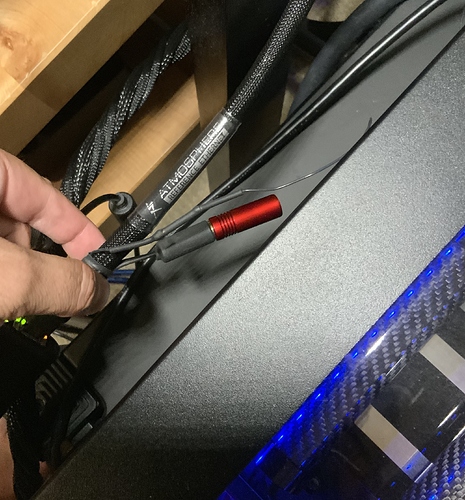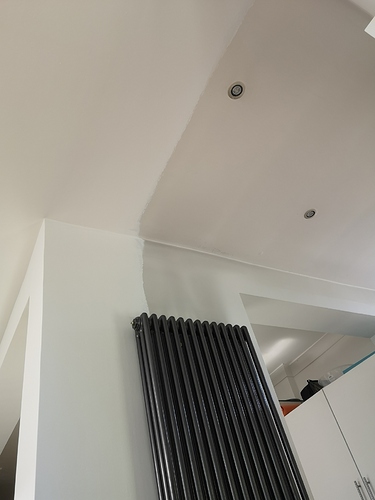Again, stick it to the man 

I’ve got this theory that audiophiles cannot play golf. For those who don’t play golf, which according to my theory will be everyone reading this site, when it comes to putting you lean over behind the ball looking at the hole to decide if the slope is going to move the ball left or right on its journey, and take that into account when hitting the putt. I was told years ago that if you can’t see anything, just hit it straight. Audiophiles in principle should not be able to reconcile themselves with this. They would be convinced that it had to move one while the other even by the distance of a couple of blades of grass. Some might get through 3 holes of golf before nightfall, others might not get past the first putt before being hauled off to the lunatic asylum. What they don’t realise is that even it a few blades of grass off-line, the ball will still go in the hole. Worrying over those last infinitesimally small margins won’t make a difference. what does make a difference is that, after deciding were to hit the ball, they don’t hit it hard enough and it is guaranteed 100% that the ball will never go in the whole, which gets me to my theory about valve amplifiers. What audiophilia and golf do have in common is that plenty of golfers think that if they have more expensive equipment they will play better. I reckon, If they set their mind to it, Blue Jeans Cables could make very good cheap golf equipment.
Sure everyone scores better in golf with wooden drivers and blade irons. In both golf and audio technology marches on,
So that was my problem this morning. I’ll just stay home tomorrow and listen to Prog or swap cables.
Right on the money! I tried a bunch of different ethernetcables (shielded not shielded) in a whole bunch of different prize categories and I couldn’t hear any differences whatsoever. Then I switched over to WiFi and immediately heard an SQ improvement. Then again I am using an Aries G1 which is optimized for WiFi. But I guess the sonic improvement I noticed when using WiFi is probably because of some noise coming from the Ethernet cable. If your network player supports it give WiFi an A/B.
These Sablon cables are starting to come into their own now: they’re very, very good.
I’m a member of a golf club, the one nearest to Central London, but usually hate the game and haven’t been for a couple of months.
My hifi is in our family room. Moved it out Wednesday night, Thursday the room was repainted and new skirting installed (with a new AQ ethernet cable and fibre optic behind it), and last night I cleaned all the woodwork and glass, moved back the furniture and reinstalled the hifi. Think I fell asleep on the floor and was woken by workmen at 6am. Took an hour this morning to finish up, signal path from modem to streamer via server is 3 x BJC 1m CAT6 and 1 x 25m fibre with two TPLinks and all shiny and lovely. An absolute f****** pain doing all this, might go play some golf tomorrow to let off a bit of steam.
After and before …
I’m prepared to believe things make a difference.
In the analog domain certainly things can make a difference because it’s the music signal itself which is rushing through those cables and opamps and connectors.
In the good old days, digital cables to simple DACs could certainly make a difference, because the conversion from bits to analog was done sans buffering in the DAC.
But… with ethernet and USB, the data received is buffered. It’s stuffed into one end of a buffer while data to be converted to analog is sucked out the other.
I can believe the timing of the data sucked out of the buffer is affected by evil analogue things, like a power supply variation. Such variation could be caused by weird timing behaviours on the process of stuffing the data into the buffer (etc). Obviously, the DAC can affect things.
But I’m really at a loss to understand how the timing of the data being stuffed into the buffer can be affected by the ** cable **.
So what are the theories?
There aren’t any. We are making assumptions about the potential issues or reading marketing which might suggest all sorts of strange phenomena a cable can fix. There are essentially two issues. Data transfer and noise transfer. A cable cannot ‘fix’ a data issue and the reality is data issues do not happen unless cables are wildly out of spec or there is a fault somewhere. Noise transferred into a sensitive device like a modern DAC is a potential issue. More with USB by the nature of the way it works. But this is something most USB treatments seek to fix. But good design will also take care of those issues, and those better designs are making their way into products these days. Ethernet Isn’t as straight forward and I am still figuring that out. My experience tells me short runs in electrically quiet environments shouldn’t present any issues whatsoever. But who here strictly separates power, signal and digital cables in their homes? I do at work but at home I’ll admit I don’t pay it much attention and even run my Ethernet through power.
 hehehehe well sometimes ya gotta do what ya gotta do. I would only use this EoP type setup in a last resort situation. I would even consider a WiFi bridge to the other area if that was workable before I went EoP - but that’s just the network engineer in me (maybe).
hehehehe well sometimes ya gotta do what ya gotta do. I would only use this EoP type setup in a last resort situation. I would even consider a WiFi bridge to the other area if that was workable before I went EoP - but that’s just the network engineer in me (maybe).
For me it’s wired all the way wherever possible. Bar mobile devices of course.
It is in the pipeline! It causes noise on my phono stage but wireless doesn’t work as well functionally for me. Add to that my DAC has Ethernet and Bluetooth but no wireless!
When I used EoP I found the lower speed ones led to less interference with my phono stage. Also using a Tachima filtering mains block, pretty much got rid of it altogether.
Mine is very much a house wide setup serving three rooms and doing video streaming duties too. We are in a bit of limbo at the moment as my other half is contemplating a move closer to our daughter so a decision will be taken when we know what is going on. But I do have two slower and two faster ones so I may experiment at some point.
If you’re computer savvy, testing Ethernet cables is one of the easiest things to do. Set up your pricey cable and a normal cable in an IP team or bond and individually bring them up and down in the OS and listen for the difference.
Doubt there will be any (duh) but it’s a great test for people who think there will. You could even setup a script to do it blind for you. If there’s a difference you should easily be able to match the better sound quality periods with the random switches.
Until last week, I was in the sceptical camp on this topic. Then I replaced the cables between a Melco N10, an ND555 and a Netgear switch. The improvement was astonishing. I don’t understand it, but can’t argue with such a change for €25!
I don’t doubt you hear a difference, but a double blind test with someone else bringing up and down the interfaces, as described above, would be interesting.
Belden by any chance?
Sorry, yes, didn’t mention the name because I knew I would be immediately asked for chapter and verse on precise product detail, which I didn’t have to hand. My point here is that there is more than Snake Oil to this, although I can’t explain it.
No one can seem to explain it and it effects different systems in different ways. Noise shaping seems to be the latest theory and different cables seem to effect this.
For a long time I have avoided “audiophile” Ethernet cabling for many of the reasons mentioned in this thread. I was wrong, but the impact they might have will be system dependent. My set up uses a Sonore opticalModule in my workroom (where the server and all the commercial computer gear is) with an optical fiber cable running to my Sonore Renderer. The opticalModule is a critical link, and it responds well to things like high performance linear power supplies-this indicates that how much noise which gets into the oM matters.
So, I tried a single, 1 meter, Sablon Audio Reserva Ethernet cable going from he switch to the oM. There were definite, easily audible improvements in low level resolution, instrumental textures, reverb tail definition, etc. All the usual things which get better when the noise level is reduced in my experience. Now, these differences are not “massive”, but they certainly are significant enough to me to matter.
BTW, the Sablon does not ground the shielding through the plugs at both ends, so no worries about ground current noise here.
Now, in a non-optimized system I would not recommend spending the cash on an Ethernet cable, but when one is looking for that last little bit of improvement, the Sablon cable is worth trying (I have the 2020 version which is updated over previous models).

